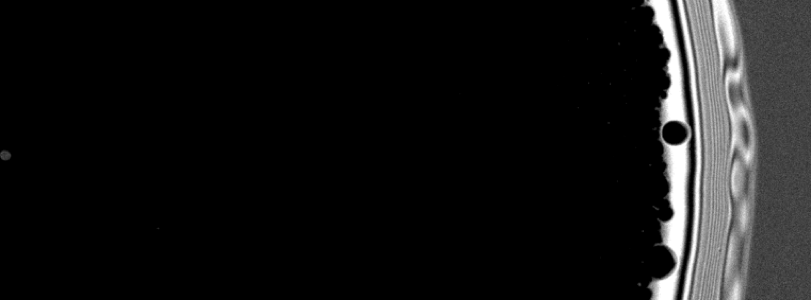Drop splashing
a 3 mm drop of ethanol impacts a dry surface at:
How does a drop of liquid splash when it hits a smooth dry solid surface? Our intuition tells us it must splash and eject thousands of tiny droplets. We would expect the same behavior anywhere - here on Earth, on Mars and on the Moon. We would be wrong! In collaboration with Wendy Zhang, we have found that we can suppress splashing completely by removing the surrounding atmosphere. A drop which splashes in Chicago would not necessarily splash on the top of Mt. Everest where the pressure is less and would definitely not splash on the Moon which has no atmosphere.
a 3 mm drop of silicone oil impacts a dry surface at:
The mechanism by which the gas affects splashing remains unknown. Recently, we used high-speed interference imaging to measure the air beneath all regions of a spreading viscous drop. Although an initial air bubble is created on impact, no significant air layer persists until the time a splash is created. This suggests that splashing in our experimentally accessible range of viscosities is initiated at the edge of the drop as it encroaches into the surrounding gas - not by air trapped beneath the drop at impact.
High-speed interference image of a viscous splash (~10x viscosity of water). The large, black central region indicates liquid-solid contact - there is no entrapped air under the central region of the drop. Interference fringes appear underneath the ejected sheet, indicating a very thin (~5 micron) layer of air.
Publications:
"Airflows generated by an impacting drop," I. Bischofberger, B. Ray, J. F. Morris, T. Lee, S. R. Nagel, Soft Matter, 12, 3013-3020 (2016).
“Scaling of the Splash Threshold for Low-Viscosity Fluids”, Cacey S. Stevens, EPL 106 24001 (2014).
“Comparison of splashing in high and low viscosity liquids”, Cacey S. Stevens, Andrzej Latka, S.R. Nagel, PRE 89 063006 (2014).
“Seeing the invisible – air vortices around a splashing drop,” Irmgard Bischofberger, Kelly W. Mauser, S. R. Nagel, Phys. Fluids 25, 091110 (2013).
“Creation of prompt and thin-sheet splashing by varying surface roughness or increasing air pressure”, A. Latka, A. Strandburg-Peshkin,
M. M. Driscoll, C. S. Stevens, and S. R. Nagel, Phys. Rev. Lett., 109, 054501 (2012).
“Ultrafast Interference Imaging of Air in Splashing Dynamics”, M.M. Driscoll and S.R. Nagel, Phys. Rev. Lett., 107, 154502 (2011).
“Thin Film Formation During Splashing of Viscous Liquids”, M.M. Driscoll, C.S. Stevens, S.R. Nagel, Phys. Rev. E 82, 036302 (2010).
“Splashing of liquids: Interplay of surface roughness with surrounding gas,” L. Xu, L. Barcos, and S. R. Nagel Phys. Rev. E 76, 066311 1-5 (2007).
“Liquid drop splashing on smooth, rough, and textured surfaces,” L. Xu, Phys. Rev. E 75, 056316 1-8 (2007).
“Drop Splashing on a Dry Smooth Surface,” L. Xu, W. W. Zhang, and S. R. Nagel, Phys. Rev. Lett. 94, 184505 1-4 (2005).
At higher viscosities (~ 10x water), splashing looks qualitatively different. However, removing the air still suppresses splashing - this effect is very robust.
1 atm
0.2 atm
1 atm
0.2 atm
